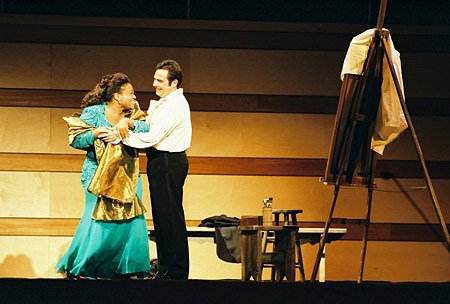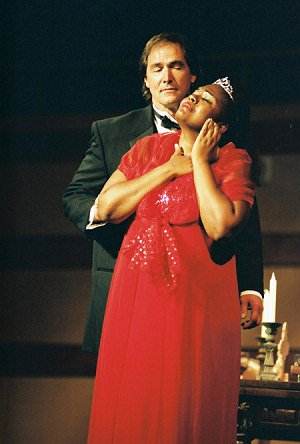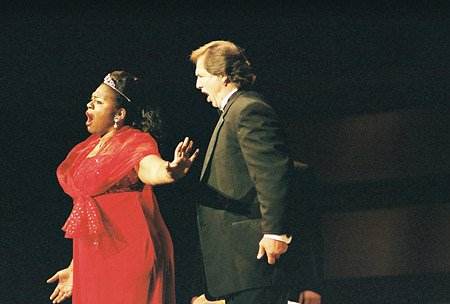S & H International Festival/Opera Review
Aspen Festival 2003: PUCCINI: TOSCA, Aspen Festival Orchestra, David Zinman, conductor. Benedict Music Tent, Aspen, Colorado, USA, 19th July 2003 (HS)
Even though two of the three lead singers canceled, the Aspen Music Festival triumphed with its semi-staged presentation of Tosca thanks to the one holdover, tenor Alfredo Portilla as Cavaradossi, fill-in soprano Lisa Daltirus in the title role, and especially conductor David Zinman, who ought to conduct opera more.
Lisa Daltirus Tosca Alfredo Portilla as Cavaradossi
Doing opera in a 2,050-seat space designed for symphonic and chamber works puts the emphasis on the music. Some of us think that's a pretty good idea, especially when the musical values are as deliciously achieved as they were here. Zinman drew extraordinarily fine playing from the Festival Orchestra, the ensemble comprising principals from leading orchestras (including a few from opera orchestras, including the Met's) filled out with select students from Aspen Music School. Zinman got the big dramatic gestures and most of the small ones, exhibiting a flair for Puccini's shifting tempos, making them sound as natural as a heartbeat.
Soprano Carol Vaness was originally scheduled to sing the title role, but illness sidelined her after her arrival in Aspen the weekend prior. Baritone James Morris also got to Aspen and participated in a few rehearsals before succumbing to an illness. Daltirus arrived on Monday in time for all the rehearsals as Tosca. Louis Otey was already the understudy for Morris.
From her first offstage utterance of "Mario! Mario!" Daltirus was impressive. She has a purity to her voice, something short of a full spinto at the top but lacking nothing in creaminess and clarity. Her chest voice has power, a requirement for any dramatic Tosca. Her acting was especially good in Act I and Act III, conveying the contradictions of her relationship with Cavaradossi and her fear and revulsion of Scarpia. In Act II, she could have done more with the extended business over Scarpia's corpse, but the push-pull with Scarpia came off splendidly and "Vissi d'arte" not only was musically satisfying but dramatic as well. This is a singer on the brink of stardom.
In his scenes with Tosca, Portilla, a natural lyric tenor, invested Cavaradossi with a sweetness reminiscent at times of José Carreras. When he needed it, he could also call up enough squillo to give his "Vittoria, vittoria!" plenty of ring in Act II. "Recondita armonia" set the tone with elegant, lyrical singing, but his finest moments came in Act III. The rapport with Zinman and the orchestra was palpable as Portilla caressed "E lucevan le stelle" (set up beautifully by Joaquin Valdapeñas' gorgeous clarinet solo), and the opening phrases of "O dolci mani" couldn't have been more tender or moving.
Lisa Daltirus Tosca Louis Otey ScarpiaOtey made Scarpia into the right combination of smarmy elegance and sheer terror. He experienced some sort of vocal issue toward the end of Act II, causing him to crack on several notes, but it seemed to be temporary and he recovered to finish strong. He is a strapping man with a big voice, though not quite big enough to power through the Te deum in Act I. The confrontation with Tosca generated more than few sparks.
The smaller roles were handled by students in the voice and opera program, some of whom, like bass Yung-Bok Kim as the Sacristan and baritone Brian Mulligan as the revolutionary-on-the-lam Angelotti, are already singing professionally on major opera stages. Kim was especially good, investing the Sacristan with a stooped walk, an appropriately testy personality and a rich, focused bass.
The staging was done by Edward Berkeley, who heads the opera programs at Julliard and Aspen, his direction conveying the story and the personal relationships as they develop rather than imposing directorial flagrances. Berkeley is especially good at linking what the singers do on stage with the music, often with subtle touches involving the way they react to each other to set up the next line.
The orchestra was positioned slightly off center, surrounded by raised platforms for the singers to move around on. The production also made use of the choir loft that wraps around the back and sides of the stage. Lighting and a few props suggested the chiesa Sant'Andrea della Valle in Act I, Scarpia's rooms at the Palazzo Farnese in Act II and the ramparts of Castel Sant'Angelo in Act III.
That was enough, especially with Zinman shaping a performance that gathered momentum irresistibly.
Harvey Steiman
Note: Harvey Steiman will be writing regularly from the Aspen Music Festival through its conclusion in mid August.
Lisa Daltirus Tosca Louis Otey ScarpiaPhotos: Alex Irvin.



 Return to:
Return to: